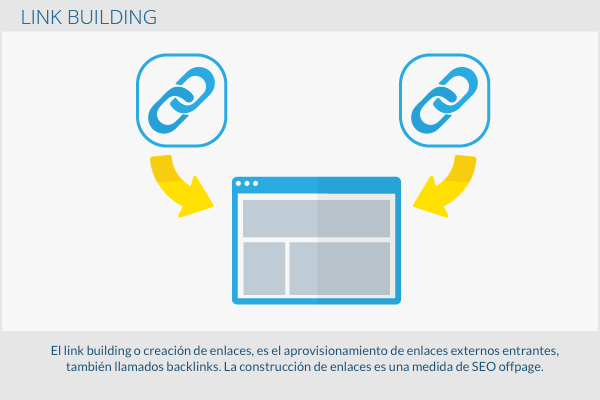The link building or link building, is the provision of incoming external links, also called backlinks. Link building is an offpage SEO measure.
Background
Since the launch of Google, websites no longer have to register with search engines due to Google's new algorithm that checks websites based on their incoming external links. This gave SEOs the ability to positively influence the positioning of their websites through the collection of external inbound links. Previous tests have partly shown that a faster increase in rankings is feasible through link building. Thus, a new branch of search engine optimization emerged that focused primarily on acquiring external links. Regardless, the dark side of link building came with it. Dubious link building methods like automated backlink setup, link rings, link buying and selling plus were used more widely.

What does the link building currently mean?
Google's ranking algorithm is constantly being improved and developed. At this point, link spam is usually detected in a short period of time. Search engine providers note that backlinks are still an important factor in search engine rankings. Google's Webmaster Guidelines explicitly prohibit hot link building, since they can be interpreted as an attempt at manipulation. Despite everything, according to Google, getting recommendations in the form of links should be the goal of webmasters.
Since the main algorithm change, specifically the 2012 Penguin update, many websites were penalized if they had poor quality backlinks, automated or paid links. As a result, many websites were penalized with a drop in ranking or were completely removed from the Google index. This update showed the importance of good backlinks once again. Google now has a link reject tool to verify links to its web portal in Webmaster Central.
Options
There are a large number of alternatives to get links from other websites to your own. Below are the most common link building methods:
- Do nothing. Good content is linked by users.
According to Google, this is the best way to generate links. The content of the web page must have an added value so that users recommend the information in the form of backlinks to their own pages.
- Entries in web directories and post directories.
Previously, it was a simple and cost-free manual, semi-automatic or automated link generation method. At this time, despite everything, this method has become useless, since the Google search engine recognizes the backlinks of the web and the directories of the post and they are generally ignored.
- Entries in relevant forums.
Backlinks used to be generated by setting up a forum signature, where you had the option of leaving a web address. By posting in a forum you created a backlink to your own website. This type of backlink generation is also known to Google and is now largely ignored.
- Blog comments.
Many blogging systems allow you to refer to a web page in the comment section. When posting a comment to a blog, a cross-reference is generated to the commenter's web portal. This method has been widely used as a spam technique through the automated generation of blog comments or manual comments that were of no real benefit.
- Link exchange.
A very popular no-cost method that can work, if you think about it right. Two websites exchange links on which the exchange is coordinated. The advantage is to look for explicit sites where a link can be published and the position of the links in the text can be established or the link text can be specified. In many cases, this method is also detected by Google, especially with reciprocal page links.
- Buying links.
Many website owners have made a business to market link building as a service. This method is completely disapproved by Google. Google advises that it will exclude buyers and sellers of links from the search engine index.
Content marketing instead of link building
Due to improvements in Google's algorithms and rapid detection of link tampering, it has become a difficult task to get high-quality cross-references from other websites. Therefore, the trend is towards the creation and marketing of web page content, the so-called content marketing. The aim is to offer added value through the presentation of information and content of interest that, at the same time, will lead to a large number of links and mentions. If the content of the web portal represents a real benefit for users, it will also be highly valued by search engines and better positioned in the rankings.
Web Links
- Google Webmaster Central - Quality links to your website
- Matt Cutts Video - What does Google think of post marketing links, widgets, etc?



